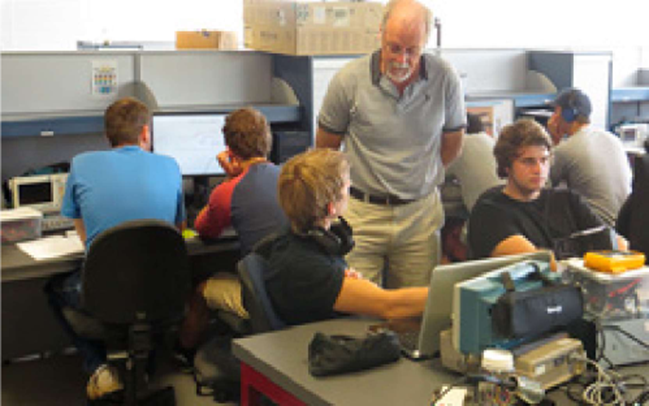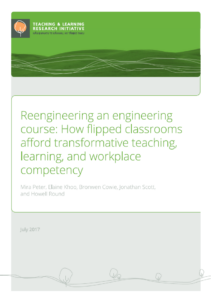Introduction
Successful engineering graduates need to understand engineering principles and practices and be able to work in teams, to communicate well, and to work in contexts that can be risky and uncertain (Adamson & DarlingHammond, 2012; Meier, Williams, & Humphreys, 2000). Current trends in engineering education call for the development of students’ technical and non-technical skills (Male, 2010). Thus, it is crucial that tertiary educators develop curricula that enable students to develop these capacities and to enhance their employability and contribution to a country’s economic competitiveness and societal wellbeing (Ministry of Education and the Ministry of Business, Innovation and Employment, 2014).
This project extends our previous research on the effectiveness of the threshold concept theory in enhancing tertiary teaching and learning across disciplines including engineering (Peter et al., 2014). Threshold concepts (TCs) are those disciplinary concepts that students need to master in order to think like a subject specialist (Meyer & Land, 2003, 2006) and current identification of TCs and competencies in engineering has broadened beyond content/technical knowledge to include skills such as teamwork and communication (Male & Baillie, 2014; Male & Bennett, 2015). Given that tertiary education aims to better prepare students to apply what they know in new ways in the real world and novel situations (Tertiary Education Commission, 2013) it is imperative that students master TCs, competencies, and practices in order to reinforce their conceptual development and “threshold actions” within and outside the classroom.
In this project, we investigated how a flipped classroom approach can influence student learning of technical skills (e.g., TCs) and non-technical skills (e.g., communication, teamwork), both of which are needed in an engineering workplace. For the purposes of the study, workplace competencies are defined as the appropriate application of knowledge, skills, attitudes, values, and behaviours in the engineering workplace (Billett, 2014). Flipped classrooms share many characteristics with other learner-centred approaches (Bergmann & Sams, 2012) that can foster active student learning (Karabulut-Ilgu, Jaramillo Cherrez, & Jahren, 2017). In a flipped class, lecture materials are assigned as take-home tasks (e.g., readings, watching video resources) for students to complete prior to attending face-to-face classes. The class time is thus freed up for the application of the learned ideas through active in-class student inquiry, collaboration, and to address student questions and misconceptions (Strayer, 2012; Strayer, Hart, & Bleiler-Baxter, 2016). These activities can help students master TCs (O’Toole, 2013) and develop the skills required of 21st century graduates (OECD, 2012). It is argued that, by flipping the class, the lecturer’s role changes to that of a facilitator of learning who provides students with different ways to learn content and demonstrate mastery; offers students opportunities to actively participate in meaningful learning activities; scaffolds these activities; and conducts ongoing formative assessments during class time (Halili, Abdul Razak, & Zainuddin, 2014). Given the above, we hypothesised that a TC-based flipped class may enhance first-year students’ learning of the technical and non-technical skills necessary for engineering graduates in the 21st century.
Research questions
The research was guided by the following questions:
- How does an extended flipped classroom approach impact on the teaching of TCs?
The results will assist lecturers to identify flipped pedagogical practices to help make difficult concepts more explicit and accessible to students. - How does an extended flipped classroom approach impact on student learning of TCs?
The results will indicate the value of the flipped model and its associated strategies for student learning? - How does student learning through an extended flipped classroom model translate into their development of important workplace competencies?
The results indicating changes in students’ developing non-technical competencies will be of interest.
Methodology and analysis
The research context
Introduction to Electronics is a compulsory undergraduate engineering course. Prior to this project the course consisted of three 1-hour face-to-face lectures, online tutorials (e-tutes), and one 3-hour laboratory session each week during a 12-week semester. Each student was expected to attend all lectures and one of five laboratory (lab) streams. Our earlier studies evidenced the effectiveness of a TC-focused curriculum (i.e., Thevenin’s theorem (TC1) and Dynamic Resistance (TC2)) and the implementation of online tutorials (Peter, et al. 2014). In the current study the course lecturers decided to extend the teaching and learning by introducing the flipped class approach.
Participants
Two experienced lecturers (Lecturer 1 and Lecturer 2) and students enrolled in the course during each cycle/ semester of the flipped class participated in the research. Lecturer 1 taught the analog section of the course covering TCs 1 and 2 in the first half of the course, while Lecturer 2 taught the digital section in the second half. The project ran over five semesters—2015A, 2015T, 2016A, 2016T, 2017A. Semester A of any year runs for 12 weeks (March–June) while Semester T runs for 6 weeks (November–December). The two lecturers taught the course from 2015A to 2016A. In 2016T, Lecturer 1 was replaced with a new lecturer. In 2017A, Lecturer 2 taught the entire course alone. Further information about the intervention in each semester is provided in Appendix 1.
The research design
Using a design-based research method (Collins, Joseph, & Bielaczyc, 2004) five cycles of flipped class were implemented where each cycle was enhanced in terms of the course design, materials, and assessment based on the results of the previous cycle (see Table 1 in the appendix for details). From 2015T onwards, personalised letters were sent to students enrolled in the course prior to the first class to describe the flipped class intervention and set coursework expectations.
Designing the flipped class
Purpose-made videos. In 2015A, the first (pilot) cycle of the study incorporated a partial flip and face-to-face teaching (see Table 1 in the appendix). The weekly 50-minute lectures by Lecturer 1 in weeks 2–4 were replaced with 33 short (4–13 minutes long) purpose-made TC-focused videos using recommendations from cognitive models (Sorden, 2005) and resembling Khan Academy (2015) videos (see Figures 1 and 2).
Figure 1 and Figure 2: Sample screenshots from Lecturer 1’s Khan Academy-style videos

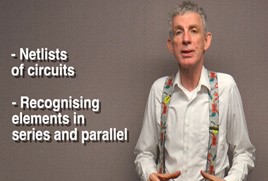
In the second cycle (2015T), a fully flipped course was implemented. Lecturer 1 converted his remaining materials into short videos using a Lightboard system (see Figure 3).[1] Lecturer 2 used his 50-minute-long course-cast videos from the previous semester.
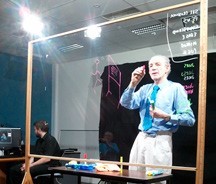
The third cycle (2016A) was the first fully flipped class where both lecturers’ videos were short and purposemade (see Figure 4 for a screenshot from Lecturer 2’s video). In all cycles, students accessed the videos by logging into the course learning management system (Moodle).
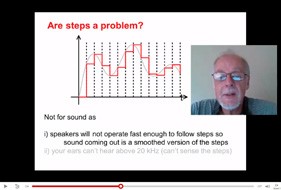
Problem-solving activities. The lecturers devised questions/problems related to particular week’s videos and the practical lab work. During the face-to-face in-class time, students worked in pairs (dyads) or in groups of four (Figures 5 and 6) to solve these problems, with lecturers and demonstrators at hand to help. Students could use their notes and re-watch videos while solving these problems or during the lab work (Figure 7). In 2015A, 2015T, and 2016T one-hour-long problem-solving activities directly preceded the practical lab work (3 hours) and took place in the lab space where 36 students could be accommodated. In 2016A and 2017A the problem-solving activities took place in a large lecture theatre and, although students were asked to watch videos ahead of time, there was no control over who attended these classes or whether the students watched the necessary videos before these sessions.
Figure 5 and Figure 6: Group problem solving in the lab and asking for the lecturer/demonstrator’s help when needed (2015A, 2015T, 2016T)
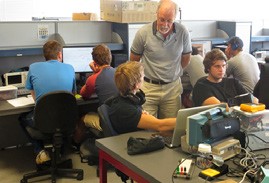
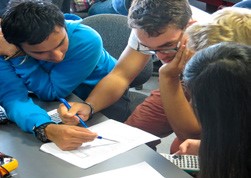
Figure 7: Students referring to the flipped class videos when needed during their group problem-solving activity (2015A, 2015T, 2016T)
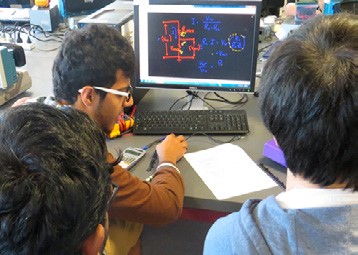
In all cycles, lecturers devoted some of the laboratory time to 10–15-minute mini-lectures to address students’ questions posted on Moodle or related to test results.
In the final 2017A cycle, in addition to the mini-lectures during the lab, the lecturer would take the first 30 minutes of the class session at the beginning of each week to briefly review the theory for that week, outline what students would be doing in the lab, and point out any potential pitfalls. The following day, in the same space, students attended the problem-solving activities similar to previous cycles. These sessions were not monitored for attendance and students often finished their work in less than an hour.
Video watching. In all cycles, students were asked to watch the relevant videos prior to attending the problemsolving activities and laboratory work. Weekly reminders to watch the videos and reference to specific videos helpful to each week’s learning were sent to students before coming to the class. The video analytics were checked prior to laboratory sessions to ascertain that students had watched the videos. However, students were not penalised if they did not watch the videos prior to coming to class until cycle 4 (2016T). From 2016T the lecturers turned students away from the labs if they had not watched that week’s required videos. Students were only allowed back in after they had watched a majority of the required videos.
Assessment. Using the Immediate Feedback Assessment Technique (IF-AT) cards, students were assessed in two quizzes and a final exam in the first cycle (2015A). In all following cycles students were assessed continuously: biweekly in cycles 2 and 4 and weekly in cycles 3 and 5.
Data
- Lecturer interviews. At the start of the project and after each cycle, lecturers provided their views and reflections on the impact of the innovation on their teaching and student learning.
- Interviews with students’ workplace supervisors. Supervisors were interviewed at the start of the first cycle to ascertain industry expectations of engineering students and to inform the development of the student surveys.
- Student surveys (pre- and post- each cycle). These surveys provided information about students’ views about and evaluation of the impact of the flipped class on their learning.
- Student achievement data. Data were collected from each cycle.
- Student focus group interviews. Students were interviewed at the end of each cycle to obtain in-depth understanding of their learning experiences.
- Video analytics of the student use of the lecturers’ purpose-made videos for each cycle. These were used to understand how students were accessing and using this resource.
- Observations. Observations (field notes and video recording) of selected classes and lab work where TCs were taught were used to help understand student learning.
Complete data sets were collected in cycles 1–4 (2015A–2016T) and these data are the focus of our analysis. In cycle 5 (2017A), only achievement data and video viewing data were collected and reported where appropriate.
Data analysis
Each form of data was analysed separately and then triangulated to address the research questions.
Quantitative survey data and achievement data were analysed for trends and changes (e.g., ANOVA) using SPSS 24 software. Open-ended survey questions were analysed thematically for each cycle and collated across all cycles when possible. Interviews were transcribed and imported into the Nvivo (version 10) qualitative software package, a thematic analysis (Braun & Clarke, 2006) was conducted, and emerging themes were discussed during team meetings. The videotaped data of student problem-solving activities were imported into the Nvivo 10, coded thematically to understand student learning (in cycles 1 to 2), and in cycles 3 to 4 to understand the impact of the flipped class on students’ developing understanding of TC learning through the kinds of dialogue they undertook. Herrington and Oliver’s (1999) communication-based coding was used to analyse the kinds of dialogue occurring. The four types of dialogue/behaviour were of interest:
Higher-order dialogue occurred when students took in new information and assimilated it with known information to rearrange and/or extend it to achieve a purpose (e.g., imposing meaning, making judgements, providing multiple perspectives, proposing a path of action, uncertainty, etc.).
Lower-order dialogue consisted of talk, which was routine, requiring little thought, or the application of wellknown rules (e.g., reading a problem aloud).
Procedural dialogue referred to non-verbal behaviours that related to the task (e.g., using software or a calculator).
Social dialogue occurred when it was related to the task at hand (on task) or not related to the task (off task).
Findings were triangulated across multiple data sources and discussed during regular team meetings when there were opportunities for member checking of data by participants (Lincoln & Guba, 1985). A collaborative team approach was adopted to identify patterns, seek explanations, and ensure collective commitment to ongoing refinements (Armstrong & Curran, 2006).
Key findings
Research Question 1: Impact of the flipped classroom on the teaching of engineering TCs
It took lecturers approximately 2 weeks to become familiar with the technology tools for creating the videos and become confident with the process—from storyboarding to recording videos. The preparation of videos allowed lecturers to rethink and redesign their curriculum and present key concepts in a focused manner. The help from a research student in editing videos was highly appreciated. A key advantage of the purpose-made videos was their reusability for future courses.
Lecturers’ reflections and interviews across the 2 years highlighted that they were positive about the impact of the TC-based flipped class approach on their practice. Despite the additional workload when preparing teaching materials (i.e., videos, problem-solving activities, questions for continuous assessment), lecturers felt that their efforts were worthwhile in creating a more focused, engaging, and productive learning experience for students. Lecturer 1 noted: “It’s been fun … but it’s hard work.”
Lecturers thought that flipping the class was really helpful in enhancing their teaching. Although it was much harder to set up the course, compared to traditional lectures, lecturers felt that the flipped class worked much better once the effort had been made. They felt that it was much more satisfying and that it did more for the spirit of learning in the course than anything they had done before. Lecturer 2 commented: “Just getting people working. It’s better for us; it’s better for them. It’s better for everybody.”
Lecturers also saw the value of the problem-solving exercises and continuous assessments. They felt that students were more engaged and seemed to enjoy the paper more than previous (traditional teaching and assessment) cohorts, and that the continuous assessments motivated students to keep up to date.
In the first cycle, lecturers felt that students needed guidance on which of the analog videos to watch, as they seemed a bit overwhelmed by the number of videos available. This was remedied in later cycles by lecturers explicitly telling students which videos and in which order to watch them to maximise learning. The issue with students not watching the videos in a timely manner was addressed by setting course expectations before the start of the course. In addition, during the course, lecturers informed students that their video watching behaviour was monitored and students who had not watched the videos in time were identified and in later cycles removed from the class until they watched required videos.
Lecturers thought that the in-class problem-solving activities and mini-lectures were effective in complementing the videos and that they offered students additional learning support. According to the lecturers, the overall students’ grades improved in 2017 compared to previous years. Lecturer 2 attributed the results to refusing students entry to the lab if they had not watched the videos for that week; when students watched the videos first they completed the labs more easily which lifted their morale, inspired them to work harder, thus achieving better learning outcomes. In addition, the lecturer redrafted the lab handouts and this might have further contributed to students’ better understanding and achievement.
Lecturers also felt that their communication with students through Moodle helped them develop a relationship with students (in addition to the face-to-face lab and class sessions). Lecturers commented that, often in the Moodle forum, students would talk amongst themselves and that having a lecturer present in that space advising them and commenting on their work was really important. About this, Lecturer 1 said: “Because it makes it clear to them that we’re interested in this [student questions] too.”
Overall, the lecturers were satisfied with the flipped course experience and would like to flip other courses that they will be teaching. Importantly, the lecturers felt that a combination of face-to-face teaching and the purposemade short videos would be a more effective combination that would better serve students’ various learning needs and preferences.
Research Question 2: Impact of the flipped classroom on student learning of engineering TCs
This question focuses on students’ perceptions and learning, as gauged through course assessment, student surveys, and interviews.
Student data were gathered in all five cycles, three of which were full 12-week courses (2015A, N = 130 students; 2016A, N = 124 students; and 2017A, N = 99 students) and two were intensive 6-week smaller courses (2015T, N = 31 students and 2016T, N = 23 students). Surveys were completed by a majority of students in each cycle: 2015A (N = 112), 2016A (N = 106), 2015T (N = 25), and 2016T (N = 21). No surveys were administered in 2017A.
Student achievement data
Achievement data in the flipped class cycles were compared to two previous years (2013A and 2014A) when the course was taught face-to-face, IF-AT cards were used for examination, and online tutorials were available to students. Data in 2013A and 2014A served as a baseline against which potential changes in student achievement due to flipping the class and incorporating continuous assessment later on could be measured.[2]
In general, achievement data revealed that the fully flipped class, in combination with continuous assessment, helped students learn TCs in the traditionally more challenging analog section of the course.
As can be seen in Figure 8, the results show that, with the introduction of the flipped class and continuous assessment, the average student achievement in the analog part of the course (averaged across three quizzes) increased significantly in 2015T, 2016A, 2016T, and 2017A when compared to the average achievement in the analog part of the final exam in 2013A and 2014A when the course was not flipped F(6, 687) = 32.677, p < 0.001. Achievement in fully flipped classes in 2015T, 2016A, 2016T, and 2017A was also significantly higher compared to 2015A when the course was only partially flipped. Once the class was fully flipped and continuous assessment was introduced, students’ achievement was comparable across different cohorts (i.e., 2015T, 2016A, 2016T, 2017A). Thus, in general, in the analog part of the course students’ achievement improved significantly with the introduction of the fully flipped class and the continuous assessment.
In the digital part of the course students in the 2016A cohort achieved significantly better when compared to 2013A and marginally better than 2014 when the course was taught in the traditional manner. The 2017A cohort of students did not differ significantly from other cohorts with the exception of 2016A where students achieved significantly better (p < 0.05). Thus, overall, in this part of the course students’ achievement did not change significantly with the introduction of the fully flipped class and continuous assessment.
Figure 8: Average score (across three quizzes) on analog and digital parts of the course in 2015T, 2016A, 2016T, and 2017A and in final exam on analog and digital part in 2013A, 2014A, and 2015A[3]
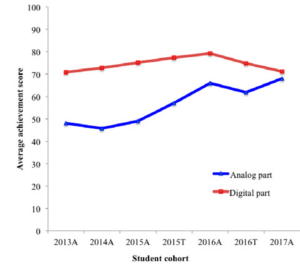
Surveys and focus group interviews
The survey and interviews highlighted themes related to the usefulness of the lecturer purpose-made videos to student learning, students’ video watching behaviour, various learning strategies students drew from to supplement their learning within the components of the flipped class, and students’ overall perception of the value of the flipped class approach to their learning.
Properties of the videos helpful to learning
The student survey data highlighted characteristics of the lecturers’ purpose-made videos that supported learning. In general, the 2015A students found Lecturer 1’s videos to be very informative and systematic. Students especially valued his drawings, explanations, and use of circuit diagrams, and simplification of complex ideas. Lecturer 1’s friendly voice (76%) that was easy to follow and informal way of teaching (74%), circuit diagrams combined with narration (82%), and listing of key ideas covered at the start of the video (57%) were identified as helpful to learning. Similarly, students appreciated Lecturer 2’s videos in providing very clear information, and his straight-to-the-point style for quick and easy learning. Students felt that Lecturer 2’s mid-video quiz questions ensured they were paying attention to the video while questions at the end of videos reinforced their learning. Another 52% of students thought both lecturers’ personal introductions at the start of videos were engaging.
Affordances of the videos and student learning
The 2015A students thought that easy access to videos (97%), learning in their own time (90%), and at their own pace (84%) were the three most valued characteristics of the video-based learning during the flipped weeks. About half of students (48%) felt that ideas in videos were well-matched to flipped activities, and around 60% of
students felt that videos provided a good overview of a topic and that it was easy to review ideas (62%) through the videos. The majority of students felt that videos helped with lab activities (54%). Only about a quarter of students felt that there was too much information in the videos while 70% felt that videos were well-targeted at their level of understanding; 69% of students said that videos helped them understand key concepts.
Student focus group data corroborated results from the surveys. Across all cycles, students liked learning from the videos. They liked the videos because “watching them was a lot easier to understand than being in a lecture”. Some students said that watching videos helped them concentrate more. Students also liked that they could go back and review videos:
It’s real good in the sense that like even now if we want to watch them, we can just watch them and because they’re shorter videos and they just get straight to the point … it’s labelled really clearly so you can just find exactly what you want.
You can stop the lecture and you can replay it if you didn’t get the lecture the first time. It was probably the best part of the course that you can re-watch it again.
I did like having the intro and the summary. The intro was good because when I watched the videos I just made a decision how much I already … pretty much that enabled me to within five seconds know how much effort I sort of had to put into focusing on the video.
However, many students remarked that:
Keeping on top of them (watching videos) was the hard bit; it puts more pressure or more dependence on a student for their own learning.
Interviews with the laboratory demonstrators indicated that having videos instead of lectures was valuable to students because they could pause the video if they did not understand a segment (especially in the case of students for whom English is not the first language), or Google the part they didn’t understand, and view the segment again—which was not possible to do in the lecture.
Video watching behaviour
Data from the 2016A students showed that about half of students (51%) watched the assigned videos before their labs, only 17% watched the videos before the weekly problem-solving activities on Monday mornings, while another 24% watched them before both weekly problem-solving activities and the respective weekly labs. This meant that many students who were coming to Monday problem-solving activities were unprepared to actively participate and this was visible in students’ general lack of engagement. This was addressed in later cycles through specific strategies lecturers adopted to encourage timely video watching behaviour (see previous section).
According to demonstrators, students didn’t watch (all) videos (in time for the flipped class and labs) because they were used to structured timetables—time and place to go to be “lectured at”. Given the freedom to watch videos in their own time, many first-year students lacked the self-discipline and procrastinated until it was too late. This observation paralleled the statements made by students themselves.
Learning from videos
Overall, more than 70% of students across all cycles found the videos useful to their learning. Almost 75% of the 2015A students found watching the lecturers’ purpose-made videos useful to their learning (72% and 61% said that videos covering TC1 and TC2 respectively were useful). As was the case with 2015A and 2015T, the majority of 2016A students reported that both lecturers’ videos were useful for their learning (77% and 87% respectively) while another 83% and 75% of students felt that the videos helped them learn the TCs in the course. This was mirrored in the 2016T semester findings with 81% and 70% of students affirming both lecturers’ videos to be useful to their learning.
However, generally only about a third of students (32% in 2015A & 30% in 2015T) felt that they learnt equally well from videos and from face-to-face lectures. Others preferred face-to-face lectures or had no preference
Other components of the flipped class and student learning
Learning strategies most useful to students are illustrated in Figure 9. In our detailed analysis we focused on those most relevant to the flipped class.
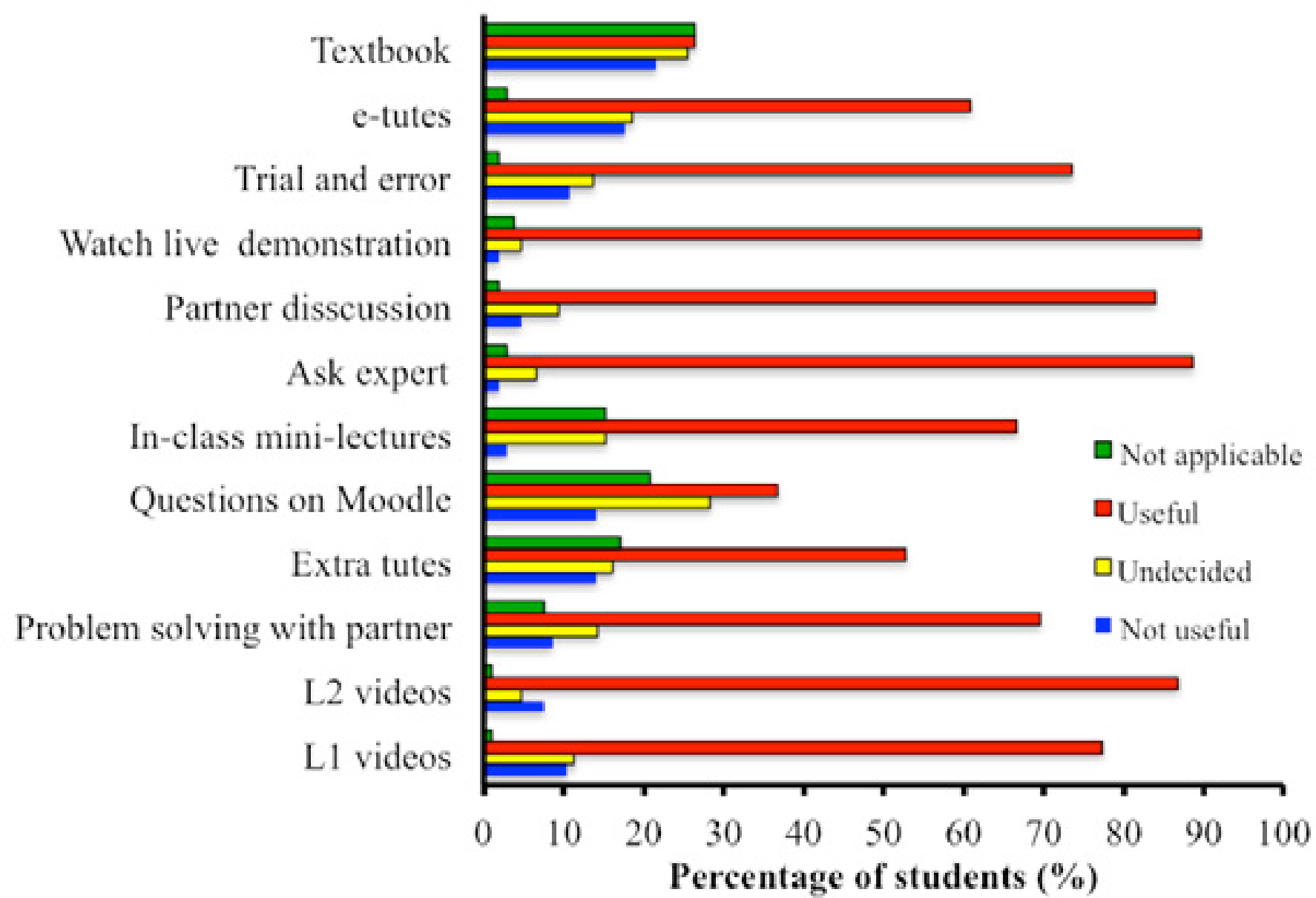
Problem-solving activities. In 2016A, the majority of students (72%) found the group problem-solving discussions useful for their learning. In focus groups, students mentioned they valued problem-solving activities because these required them to use the correct vocabulary and, together with using the IF-AT cards, these helped them explain something that they understood to others. Some students commented that, as a consequence of these group discussions, they talked to their lab partner a lot more than they would have otherwise.
Laboratory technical staff and demonstrators thought students treated the problem-solving activities as part of the lab work and that, because the group problem solving “breaks the ice” in communication between students, there was more interaction between lab partners than in the past. One demonstrator said: “I often see them, you know, talking to each other a lot more than you would had they not had that worksheet” (worksheet with questions for problem solving). They also felt that the problem-solving activities helped students to be more focused on what they were doing and that those students who had watched videos in time for labs asked fewer questions which were of higher quality than in the past.
Discussions with lab partner. In focus groups, students highlighted that working with a partner was mostly, but not always (when the lab partner did not watch videos or put the work in), a good experience. One student described the value of such discussions:
In my case, if we were a bit confused about something we would talk it over and then if I thought that I maybe like had a handle on it then I would explain my thoughts to him [lab partner] and he would think it over and go ‘oh yeah that makes sense’ or if there was a flaw in my thinking he’d point that out.
Online tutorials. Across all student cohorts, 40–60% of students felt that the online tutorials were “very useful” or “useful” for their learning and that these provided important opportunities to practise examples of concepts they were learning.
Mini-lectures. In focus groups, students highlighted the value of the in-lab mini-lectures:
I really like the lectures that are held in the labs so we can go through worksheets and then we can get explanation of what to do on the whiteboard and the lecturers are there so we can just talk to them directly.
Note-taking. In 2016A and 2016T less than half of students reported taking notes all the time (32% and 48% respectively) or sometimes (54% and 29% respectively) while watching videos. Students who took notes felt that taking notes was useful for quick revision, they could use them in labs and when working on questions, reflect on them at other times, and to understand the content in their own words.
Continuous assessment. Continuous assessment became an important feature of the flipped class design over time. About half of the 2016A students (51%) felt that fortnightly assessments helped them learn “very much”, 42% said that they “somewhat helped”, and seven students said that they “did not help” at all. Similarly, in 2016T, 100% of students felt that weekly assessments helped them learn to a certain degree. The students felt that continuous assessment “kept them on their toes” and forced them to study and learn in small chunks instead of leaving it to the end of semester. These small chunks made it much easier to stay focused and ensured that students maintained and improved understanding of the course material. Students felt that it was “good for testing knowledge and solidifying ideas” such that by the end of the course they were more confident about what they knew and were able to identify areas they needed to work on.
Face-to-face time. The majority of students (86%) in 2016T reported that they had enough face-to-face time with their lecturers, while another 50% said that the technological support (e.g., accessing online tutorials) was very adequate. In terms of interactions with their peers, 57% of students in 2016T said that they had very sufficient social interactions with their peers, while only 28% said that their intellectual interactions with their peers were sufficient. However, students felt that they needed more person-to-person help and that more examples would have made it easier to learn. This was remedied in later cycles (2016 onwards).
Coherence. The focus group interviews revealed that many students from the first cycle (2015A) felt that the content of the lecturer videos needed to be better synchronised with the questions in the problem-solving activities and lab work. Similarly, the online tutorials needed to complement the videos as did weekly problemsolving sessions and in-lab mini-lectures:
The point is you try to do the tutorials and you find that you get stuck on the tutorials because the lecture material doesn’t quite match what’s in the tutorial.
Some of these problems were remedied in the subsequent cycles. For example, a higher proportion (80%) of 2015T students than 2015A students (54%) felt that the videos helped them complete their lab work.
When the course materials cohered, students were more satisfied with their flipped class learning experience. One student said:
The best way for me to learn was to watch the course material first, do the course material, go to the lab, do the lab, and then if you’ve got time you go back and you review some of that earlier material in the light of what you’ve done in the lab and then you understand it.
Flipped class and learning
Student preference for the flipped class approach increased with refinements to subsequent cycles. After 3 weeks of flipped class in 2015A, only 20% of students said they preferred the flipped class approach while 62% preferred the traditional way of teaching and learning. In 2016A, 24% of students felt that the flipped class contributed very much to their learning of TCs and 58% said that it somewhat contributed to their learning. Interestingly, as in previous cohorts, there were a number of students who did not grasp TC1 and TC2 even by the end of the course. Regardless, the students said that it was convenient to have the luxury of re-watching the lectures on a complex topic, as commented by one student: “I only learnt Thevenin’s theorem and Dynamic Resistance through flipped class.”
In 2016A, 47% of students reported they preferred or strongly preferred the flipped approach and 15% preferred the traditional approach. In 2016T, 67% of students preferred or strongly preferred the flipped approach. In focus groups, students said that the key value of the flipped class approach was a more flexible self-driven learning compared to traditional lectures.
Video viewing analytics
Data indicated that not all students were watching videos required for the given class/lab and of those students who did watch them not all students watched all recommended weekly videos. This kind of behaviour can be equated to that of students not attending lectures and was most frequently observed in the first cycle. In later cycles, when continuous assessment was introduced and when lecturers started turning students away for not watching videos, more students started to watch videos more diligently. Figures 10 to 14 illustrate students’ video watching behaviour. In 2015A the number of students who watched videos and the number of video viewings increased and peaked in the week when TC1 was covered and right before the midterm exam (Figure 10). In this cycle it was also clear that a number of students went back to the videos in the weeks preceding the final exam (in June). With the introduction of continuous assessment, the number of students watching videos regularly became more stable. Interestingly, the number of video views was greater in the weeks leading up to (week 3) and covering the Thevenin theorem (week 4) across all intervention cycles signalling the now wellknown problems with learning and mastering this TC.
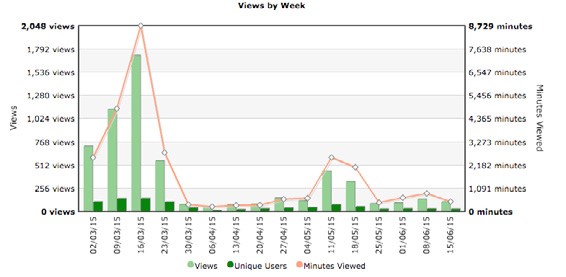
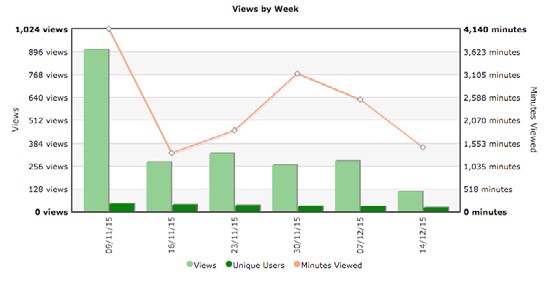
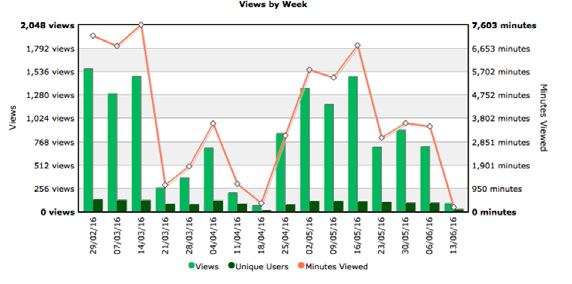
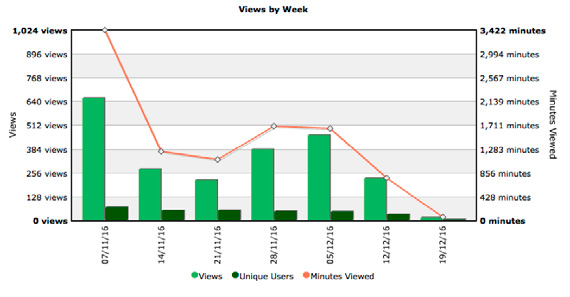
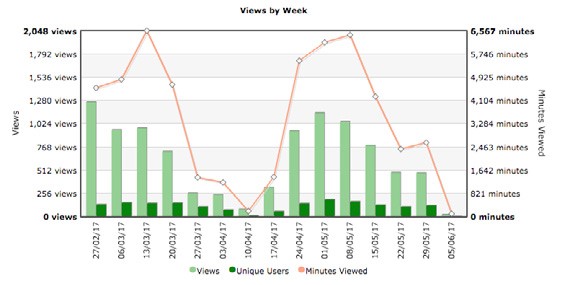
Across all cycles in the analog part of the course, videos that were watched most frequently covered the basics of Thevenin circuit theory and this was crucial for students to be able to understand the rest of the videos on the Thevenin theorem. In addition, one of these videos provided information on how to answer the first question in the lab sheet in week 3. Interestingly, across all intervention cycles the video about how to reduce the circuit using series and parallel formulae (basic knowledge) was second top ranked in terms of the number of views it received. In 12-week course cycles, 50–80% of students watched each of the seven Thevenin TCrelated videos in full; this proportion was close to 100% in 6-week course cycles.
For an in-depth analysis of students’ viewing of the seven TC1-related videos, we selected data from the 2016A cycle. We anticipated that we could uncover the reason why this TC is so hard to grasp by analysing students’ repeated viewing of various segments within these videos. Initially, for each of the Thevenin videos it was determined how many students watched it in full—the proportion varied between 38% and 68%. Subsequently, each video was segmented according to the topics discussed such as: theory behind the related topic, related calculation, practical advice for the lab etc. The time frames for the segments were selected according to the length of the topic within the video. The results revealed that there was a lot of variability in terms of who watched each video more than once. Moreover, in general, all segments within individual videos were revisited with similar frequency. Out of 124 students, 57% watched at least one segment of at least one video in addition to seeing the whole video initially. Of these, there were 10 students who watched additional segments from four or more Thevenin-related videos. Thus, at this stage it was not possible to deduce from these data what it is about this TC that makes it so exceptionally hard to master.
Video analysis of students’ problem-solving activities
The video data were further analysed to identify how students’ ideas were developing in terms of sophistication, vocabulary, and quality of interaction over the course weeks. For this purpose, we chose to analyse students’ dialogue in problem-solving activities in 2016T because this cycle was a fully flipped intervention with all the activities and videos refined. We chose three pairs of students who were present at five out of six labs that we video recorded.
Procedural behaviours were the most common behaviours exhibited by students, followed by higher-order, lowerorder, and social behaviours. The majority of the time (88%), students’ dialogue was related to the task at hand and for the rest of the time (12%), students’ talk was of the social kind (e.g., small talk, checking mobile phones, etc.). In general, while discussing problems (on task) students exhibited more of higher-order dialogue than the lower-order behaviours. Of all higher-order discussions, “path of action” was observed most often (see Figure 15).
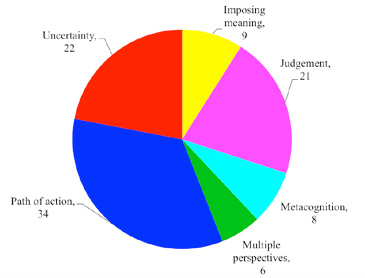
“Path of action” involved decisions about which parts of the problem to solve, what to save in the notebook, and negotiations of how to proceed. “Uncertainty” was the second most common higher-order behaviour followed by “Judgement”, which reflects students’ attempts to interpret and defend their understanding of the issues presented in the assessment. Over the duration of the course, the frequency of higher-order and lower-order talk varied. The variations in the amount and the quality of discussions seemed to mostly depend on the requirements of the problem being discussed (more sophisticated dialogue or more procedural talk needed) and less so on the students’ developing knowledge. This was observed across the course regardless of whether students were discussing TC concepts or not. Students being on task for the majority of time combined with their frequent references to the lecturers’ videos suggested that the lecturers’ purpose-made videos were helpful for learning and that they enhanced the quality of discussions.
Research Question 3: Impact of the flipped classroom on student development of important workplace competencies
Findings for this question are drawn from interviews with workplace supervisors, student surveys, and student post-work placement focus group interviews.
Workplace supervisors’ interviews
Interviews with four workplace supervisors revealed that, in addition to the necessary specialist/professional knowledge, teamwork, initiative and responsibility, communication, and willingness to learn were among the “essential skills” necessary to be a successful engineer. The exact order of these skills within the “essential” category depended mostly on the job/industry context.
Student survey and focus group interviews
Across all cycles, survey data revealed that students’ views about the importance of various workplace competencies necessary to be a successful engineer did not change much due to the flipped class (Figure 16, based on 2016A class, is representative of all cycles). When asked to rate the importance of 13 competencies, students’ responses both at the start and at the end of the course indicated that they thought all competencies were important. However, two competencies—professional responsibility and communication—had consistently lowest ratings.
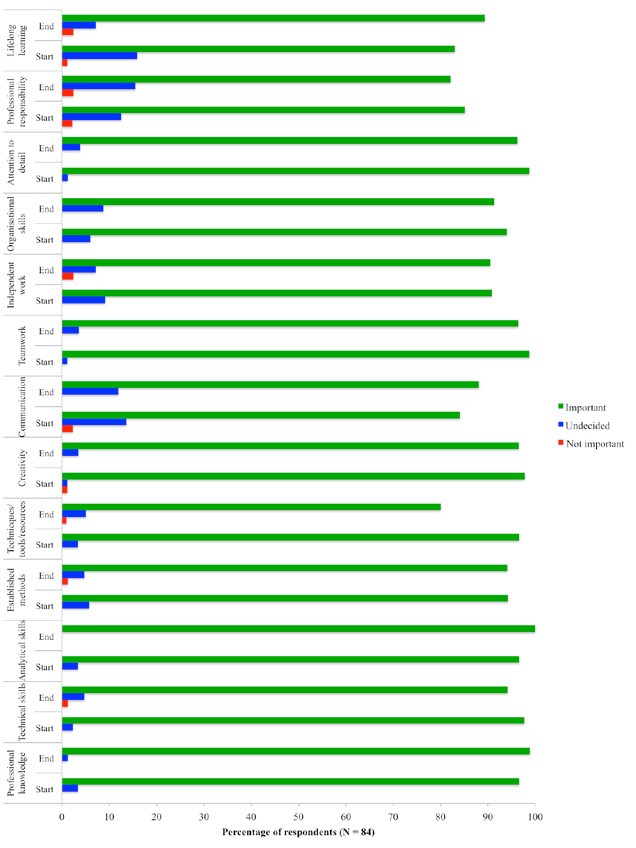
When asked which skills they developed the most during the flipped course (i.e., first, second, third, fourth most developed), in the first cycle (2015A) teamwork was second only to developing technical skills (42%) and was closely followed by learning to work independently (39%). Creativity and innovation (7%), ethics and responsibility (4%), lifelong learning (11%), and written and oral communication (11%) were the skills least frequently ranked in the first three most developed. In the second cycle, 2015T, specialist professional knowledge (26%) and technical skills (30%) were the two most highly ranked skills and these were followed by organisational skills and teamwork (13% respectively). As can be seen in Figure 17, in 2016A and 2016T, the majority of students felt that they mostly developed technical and organisational skills, followed by independent and teamwork (see Figure 17). Regardless of the ranking (1–4), students most frequently (39) listed teamwork as the competency they developed during the flipped course. This was followed by technical skills (34), independent work (28), analytical skills (27), and organisational skills (25). Professional knowledge and technical skills were the two competencies that received the most frequent top-two rankings.
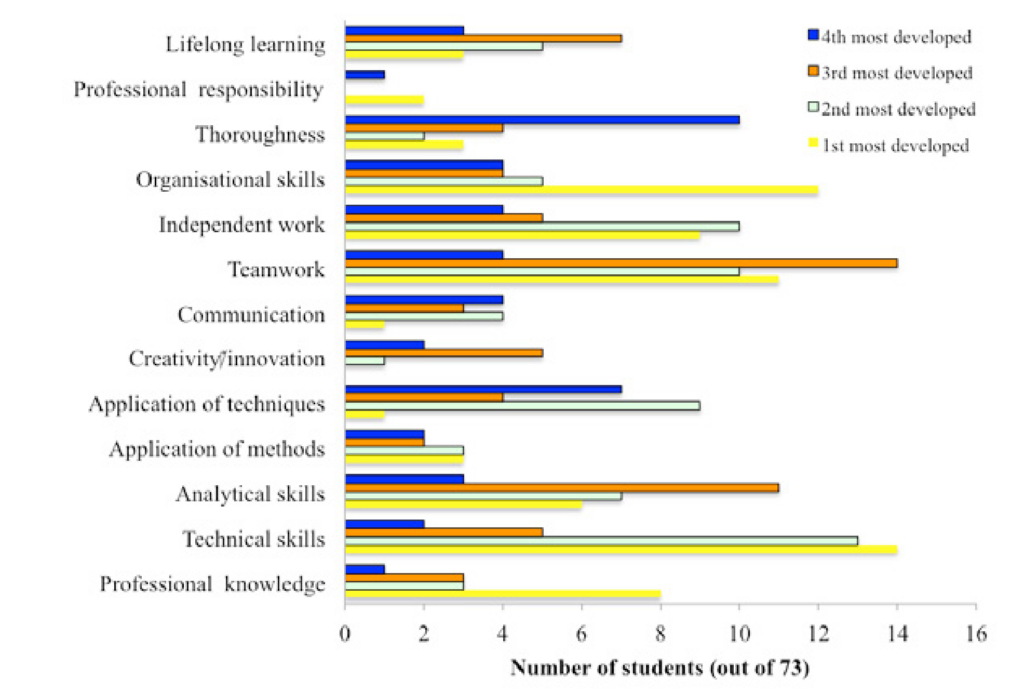
Focus group interviews with students at the end of each cycle confirmed that students thought individual work and technical skills were the most important to their being a professional engineer. Students felt that the flipped class did not contribute much to the development of their workplace-related non-technical competencies. However, during the course, students did become more aware of the importance of such skills and thought that a flipped class setup was conducive of developing non-technical skills as well. Students who had been working before they took this course felt that the course did not really help them develop work-related competencies (e.g., teamwork and communication) and they had a number of suggestions as to how this could be potentially remedied.
Focus group interviews with six third-year students who finished their work placement in 2015 (prior to flipping the course which served as a baseline comparison) revealed that they had to communicate with and explain things to various individuals who did not necessarily know about “engineering vocabulary”. These situations required students to develop and improve their communication and organisation skills, and with time they became more confident in how they organised their work and communicated with various colleagues and clients. Having to write reports caught students unprepared for using the scientific style required and they felt that it would be beneficial if there was a course focusing on scientific writing skills that was mandatory prior to work placement.
Students also felt that university courses were more structured (i.e., students are given all the information they need and the ways of solving the problem) than the situations in the work placement where they were expected to find and retrieve information and find solutions by themselves. The majority of students agreed that discussing and solving problems together (as fostered through the flipped activities) helped them learn better.
When asked to select the top three non-technical skills in terms of their importance for being an engineer the students selected people skills/teamwork, communication, and problem solving. They added that if one had basic technical skills one could learn anything (e.g., pick up the simulation software, how to communicate with one’s supervisor). Interestingly, students remarked that the ability and willingness to learn was also very important, as is being interested in what one is doing. Students also thought that some of the professional skills that they were taught as students they undervalued at the time of learning (e.g., presentation skills) but these skills had turned out to be very valuable in the workplace.
In a focus group interview with five third-year students after their work placement in 2017 (these are the students who experienced 3 weeks of flipped classroom in 2015A), all students reported that the extra hour of problem-solving exercise in the flipped class intervention did not help them to develop workplace competencies. This outcome could be attributed to the fact that they experienced only a short 3-week period of the flipped class. Students said that group problem-solving activities encouraged and “forced” them to communicate and ask questions of peers that they would not have done otherwise but felt that the experience had no direct impact on their developing important workplace competencies. Nevertheless, students felt that the experience did raise their awareness about the importance of such competencies; for example, when they encountered working with a difficult lab partner or had to negotiate to come to an agreement about a problem solution:
It made me learn to work with difficult people.
No one [in our small group] could agree on one answer and we had to take a majority vote … it didn’t work but I could see how it would help with team building and communication.
Similar to the 2015 focus group, students suggested that class presentations could be more helpful to their developing competencies such as communication. It was during the work placement that students enhanced their technical and non-technical competencies.
Finally, although students thought that developing workplace competencies was important to be competent during their work placement, differential value was attributed to different competencies depending on their workplace context and roles, affirming the workplace supervisor’s commentary on competencies needed being context dependent.
In sum, in our study we integrated a TC-based curriculum with a flipped class model of teaching and learning and continuous assessment to investigate its impact on student learning in an introductory undergraduate engineering course. Overall, students found the variety of teaching and learning activities and resources helpful to their learning and their learning of TCs in particular. The course lecturers observed an increase in the quantity and the quality of in-class discussions and efficiency of students’ problem-solving attempts, an improvement in achievement, but no major improvement in developing non-technical skills. Our findings, as well as those of others, indicate that a focus on both before-class preparation and in-class work are of essence (Chen, Wang, & Chen, 2014; McLaughlin et al., 2014; Roach, 2014) for student learning and success.
Implications
The results of our study revealed a number of conditions necessary for creating a successful and sustainable flipped class at a tertiary level. The following five areas for implications are proposed.
1. Curriculum
Refining course content and structure. By exploring strategies to foster and monitor students’ progress in learning, the lecturers developed new pedagogical approaches (i.e., flipping the class, group problem-solving activities) and assessment schedules (i.e., continuous assessment). To develop good educational materials, lecturers had to re-examine the course content and select what and how to present (e.g., clearly and succinctly) using video as the medium. The project also continually informed lecturers about the impact of the flipped class on students’ learning and they used this knowledge to further adapt their materials and pedagogy to their students’ needs.
Ensuring coherence of overall course design. The findings highlighted that the success of the flipped class requires that all class elements cohere—the weekly videos had to be relevant to the in-class problem-solving activities, online tutorials, and practical lab work. When there was no coherence, students had difficulty seeing the relevance of what they were learning. In the final cycle, lecturers provided a weekly short preview of the content to explain the “big picture” and indicate how elements were linked, to facilitate student learning.
Making incremental changes. Making incremental refinements to the course seemed to be the most effective and least stressful way of developing the flipped class. Students’ perceptions and learning in each cycle indicated the value of the TC-based flipped class approach and signalled potential areas for further refinements.
2. Pedagogy
Short, educationally good quality videos are essential. When creating educational videos that can engage and motivate students to learn it is essential to apply principles consistent with cognitive, perceptual, and attentional capacities of human learners (e.g., videos need to be short, animated, visually appealing, they need to introduce the material at the start and summarise it at the end, etc.). In terms of technical requirements for creating videos, our experience indicated that free online recording tools, a good quality microphone, an in-built video camera in the computer, and a quiet room were all that was needed. However, time and practice for developing and recording the videos cannot be underestimated. Additionally, pre-production planning and post-production of the videos was important to enhance their quality and reusability for other/future courses.
Variety of learning supports. In our study student learning was supported by lecturers’ purpose-made and supplementary online videos, in-class mini-lectures, collaborative problem-solving tasks, online tutorials, continuous assessment, “drop-in” tutorials, help from the lecturers and course demonstrators during in-class sessions, and the Moodle forum for question and answer sessions—all of which provided a variety of ways for students to learn and demonstrate mastery of the course TCs and related concepts. Such diverse learning resources and support were essential to meet students’ various learning needs.
Changing lecturer roles. Fundamental to a flipped classroom approach is the focus on active, student-centred learning. Both lecturers highlighted the need to relinquish the traditional role of “lecturer telling” to become instead a facilitator of student learning. The course structure and teaching-learning activities need to be streamlined to support students’ increasing responsibility for their own learning.
3. Assessment
Continuous assessment. In our study, continuous assessment served three main goals: (1) to reinforce students’ timely video materials viewing and practising using online tutorials, thus assisting in pacing learning; (2) to reinforce or correct learned responses; and (3) to improve the quality of students’ learning of TCs. Our results revealed that continuous assessment and feedback using IF-AT cards motivated students to keep up to date with the coursework and make connections between various educational resources. Combined with the immediate feedback from IFAT cards it highlighted the course ideas that students still needed help with and allowed lecturers to address student lack of/misconceptions in a timely manner. Our results confirm that continuous assessment and immediate feedback can improve students’ learning, motivation, engagement, and achievement (Kim, Kim, Khera, & Getman, 2014).
4. Student learning
Changing student roles. A common issue in the flipped class approach is that first-year students from traditional educational backgrounds are not used to the greater degree of self-directed learning and responsibility required. Although this was an issue in the first cycle of our study, it was subsequently mitigated through sending personal welcome letters to students prior to their attending the course in which the flipped class approach and what it entails was explained and the course expectations were described. Raising student awareness about the benefits of the flipped class early on, ensuring “buy in”, and helping them learn to manage their time and obligations (e.g., to come to class prepared) ensured the success of the flipped class and provided a basis for lifelong learning.
Learning technical and non-technical skills. The flipped class approach can promote development of both technical and non-technical knowledge and skills. In our case, students’ achievement in terms of TC learning was facilitated. Although no direct impact was seen on workplace competency development, students articulated the benefit of being aware of the value of non-technical skills such as communication and problem-solving in their learning and becoming a professional engineer. In this respect, the mini-lectures provided opportunities for further questions and enhanced students’ collaboration during problem-solving and practical lab work.
5. Institutional support
Interdisciplinary collaboration. Designing and implementing a flipped class can benefit from multiple expertise. In our study, the engineering lecturers collaborated with educational researchers, received technical support from our institution’s e-learning development team, and involved a media student to help with video editing. Such collaboration in planning, developing, and troubleshooting issues supported both educator practice and student learning.
Time and incentive for lecturers. Lecturers will benefit from having time to develop and explore the flipped class as an innovation in their practice. Our experience highlights that time and resources are needed to develop videos, refine curriculum and course content, and make incremental refinements to teaching-learning activities, teacher-learner interactions and assessment tasks. Institutions need to recognise, support, and empower lecturers’ efforts in developing their practice in support of student learning and offer incentives to support and encourage these efforts accordingly.
Limitations of the project
Two key project limitations are based on limitations in the intervention and the research design.
1. Limitations of the flipped class intervention
In cycles 1, 2, and 4, group problem-solving activities were mandatory and took place immediately before the practical labs in the laboratory setting that caters for up to 36 students. Due to the timetabling constraints, in cycle 3 group problem solving took place in a large lecture theatre, it was not mandatory, and student attendance was not taken. In this setting, the attendance was poor, and only a few students were actively working with their peers to complete the activity. A majority of students waited for the lecturer to provide answers to the problems. Although this setting did not negatively impact students’ achievement, neither students nor the lecturers found the lecture theatre space to be conducive to active collaboration or studentdirected learning.
2. Limitations of the research design
The extent to which the findings are generalisable is not certain. The study focused on the first-year, firstsemester engineering students and the results obtained with this population may differ from older students and/or different disciplines. Although the findings may not necessarily be generalisable to the wider university population, the data are sufficiently detailed to show similarities to other university contexts with similar teaching environments in which a flipped class was used. By providing rich descriptions, the findings give nuanced insights into the ways a TC-based flipped class approach can enhance the teaching and learning in engineering education.
Conclusion
The findings from this study contribute to a better understanding of the ways in which a flipped class approach can foster deeper and more meaningful learning of threshold and other concepts and inform pedagogical practice and theorising in engineering and potentially in other disciplines. Lecturers’ new ways of thinking about the curriculum they teach, and their new ways of teaching helped their students make sense of material that is challenging but essential for a deep understanding of their discipline. At the same time, the flipped class enriched students’ educational experiences and made them aware of the non-technical competencies needed in a real-life work environment. It will be exciting to see whether students’ better understanding of TCs, as a result of the flipped class, will result in better learning outcomes in the second-year advanced engineering course that builds on what had been taught in the flipped course. It is hoped that our findings will encourage other tertiary lecturers to explore ways in which they can incorporate a TC-based flipped class model in their teaching.
Acknowledgements
We gratefully acknowledge the funding for this 2-year project from the Teaching and Learning Research Initiative and sponsorship from the Wilf Malcolm Institute of Educational Research, the University of Waikato, New Zealand.
We thank our team members, the practitioner researchers, lecturers, demonstrators, research assistants, and summer scholars involved in the project for their enthusiasm and commitment over the past 2 years.
We are grateful to the many students who gave up their time to respond to surveys and participate in the interviews and to our advisory group for their support.
Last, but not least, we thank our project adviser, Professor Bronwen Cowie, for her help and wisdom in running this project. We also thank the staff of the Wilf Malcolm Institute of Educational Research and the University of Waikato for supporting us in our project.
Footnotes
- Note that Lecturer 1 himself developed the Lightboard—a clear screen that can be written on akin to a whiteboard. The produced video has images on the opposite side to the student’s point of view. These images (e.g., writing) are reversed in post-production so that they appear in the correct orientation for the viewer. ↑
- Note that in 2013A, 2014A, and 2015A students sat two midterm and one final exam—half of the final exam covered the analog part of the course while the other half covered the digital part. ↑
- Note that students in 2013A and 2014A experienced traditional classes, 2015A was flipped for 3 weeks, and 2015T, 2016A, 2016T, and 2017A were fully flipped classes. Adamson, F., & Darling-Hammond, L. (2012). Policy pathways for 21st century skills. Stanford, CA: Stanford University, Stanford Center for Opportunity Policy in Education.
References
Armstrong, V., & Curran, S. (2006). “Developing a Collaborative Model of Research Using Digital Video.” Computers & Education 46 (3): 336–347
Bergmann, J., & Sams, A. (2012). Flip your classroom: Reach every student in every class every day. Washington, DC: International Society for Technology in Education.
Billett, S. (2014). Integrating learning experiences across tertiary education and practice settings: A socio-personal account. Educational Research Review, 12, 1–13. doi:10.1016/j.edurev.2014.01.002
Braun, V., & Clarke, V. (2006). Using thematic analysis in psychology. Qualitative Research in Psychology, 3(2), 77–101.
Collins, A., Joseph, D., & Bielaczyc, K. (2004). Design research: Theoretical and methodological issues. The Journal of the Learning Sciences, 13(1), 15–42.
Chen, Y., Wang, Y., & Chen, N. S. (2014). Is FLIP enough? Or should we use the FLIPPED model instead? Computers & Education, 79, 16–27.
Herrington, J., & Oliver, R. (1999). Using situated learning and multimedia to investigate higher-order thinking. Journal of Interactive Learning Research, 10(1), 3–24.
Halili, S. H., Abdul Razak, R., & Zainuddin, Z. (2014). Enhancing collaborative learning in flipped classroom. Australian Journal of Basic and Applied Sciences, 9(7), 147–149.
Karabulut-Ilgu, A., Jaramillo Cherrez, N., & Jahren, C. T. (2017). A systematic review of research on the flipped learning method in engineering education. British Journal of Educational Technology. doi:10.1111/bjet.12548
Khan Academy. (2015). Khan Academy. Available at https://www.khanacademy.org/
Lincoln, Y.S., & Guba, E.G. (1985). Naturalistic Inquiry. Newbury Park, CA: Sage Publications.
Kim, M. K., Kim, S. M., Khera, O., & Getman, J. (2014). The experience of three flipped classrooms in an urban university: An exploration of design principles. The Internet and Higher Education, 22, 37–50. Available at http://doi.org/10.1016/j. iheduc.2014.04.003
Male, S. A. (2010). Generic engineering competencies: A review and modelling approach. Education Research and Perspectives, 37(1), 52–84.
Male, S. A., & Baillie, C. A. (2014). Research guided teaching practices: Engineering thresholds; an approach to curriculum renewal. In A. Johri & B. Olds (Eds.), Cambridge handbook of engineering education research (pp. 393–408). New York, NY: Cambridge University Press.
Male, S. A., & Bennett, D. (2015). Threshold concepts in undergraduate engineering: Exploring engineering roles and value of learning. Australasian Journal of Engineering Education, 20(1), 59–69. doi:10.7158/D14-006.2015.20.1
McLaughlin, J.E., Roth, M.T., Glatt, D.M., Gharkholonarehe, N., Davidson, C.A., Griffin, L.M., Esserman, D.A., & Mumper, R.J. (2014). The flipped classroom: A course redesign to foster learning and engagement in a health professions school. Academic Medicine, 89(2), 236–243. Available at http://dx.doi.org/10.1097/ACM.0000000000000086
Meier, R. L., Williams, M. R., & Humphreys, M .A. (2000). Refocusing our efforts: assessing non-technical competency gaps. Journal of Engineering Education, 89(3), 377–385.
Meyer, J., & Land, R. (2006). Overcoming barriers to student understanding: Threshold concepts and troublesome knowledge. Oxon, England: Routledge.
Meyer, J. H. F., & Land, R. (2003). Threshold concepts and troublesome knowledge: Linkages to ways of thinking and practising within the disciplines. In C. Rust (Ed.), Improving student learning,theory and practice—10 years on (pp. 412–424). Oxford, England: OCSLD. Retrieved from http://www.tla.ed.ac.uk/etl/docs/ETLreport4.pdf
Ministry of Education and the Ministry of Business, Innovation and Employment. (2014). Tertiary education strategy 2014–2019. Wellington: Author.
OECD. (2012). Education at a glance 2012: Highlights. OECD Publishing. Retrieved from http://www.oecd.org/edu/highlights.pdf
O’Toole, R. (2013). Pedagogical strategies and technologies for peer assessment in Massively Open Online Courses (MOOCs). Unpublished discussion paper. University of Warwick, Coventry, UK: University of Warwick.
Peter, M., Harlow, A., Scott, J., Johnson, M., McKie, D., & McKim, A. (2014). Re-envisioning tertiary teaching and learning of difficult concepts: How “threshold concepts” afford understanding of problematic ideas. Retrieved from: https://www.tlri.org.nz/tlri-research/ research-progress/post-school-sector/re-envisioning-tertiary-teaching-and-learning
Roach, T. (2014). Student Perceptions toward Flipped Learning: New Methods to Increase Interaction and Active Learning in Economics. International Review of Economics Education, 17, 74–84.
Sorden, S. D. (2005). A cognitive approach to instructional design for multimedia learning. Informing Science: International Journal of an Emerging Transdiscipline, 8, 263–279.
Strayer, J. F. (2012). How learning in an inverted classroom influences cooperation, innovation and task orientation. Learning Environments Research, 15(2), 171–193.
Strayer, J. F., Hart, J. B., & Bleiler-Baxter, S. K. (2016). Kick-starting discussions with the flipped classroom. The Mathematics Teacher, 109(9), 662–668.
Tertiary Education Commission. (2013). Growing the pipeline of work-ready engineering graduates. Wellington: Author.
Publications from the project
Khoo, E., Peter, M., & Cowie, B. (2015). Re-engineering an engineering course: How flipped classrooms afford transformative teaching, learning, and workplace competency. Journal of Research in STEM Education, 1(1), 71–76. Retrieved from http://j-stem.net/wpcontent/uploads/2015/10/6_NZ.pdf
Khoo, E., Peter, M., & Scott, J. (2015). I could replay the videos: Evaluating the effectiveness of instructional videos in a threshold concept-based flipped classroom in electronic engineering. In A. Oo, A. Patel, T. Hilditch, & S. Chandran (Eds.), The proceedings of the 26th annual conference of the Australasian Association for Engineering Education (AAEE2015) (pp. 422–431). Melbourne, VA: Deakin University.
Khoo, E., Scott, J., Peter, M., & Round, H. (2015). Evaluating flipped classrooms with respect to threshold concepts learning in undergraduate engineering. In Frontiers in Education (FIE2015): Launching a new vision in engineering education (pp. 738–741). Institute of Electronic and Electrical Engineers (IEEE), Piscataway, NJ. USA.
Peter, M., Khoo, E., Scott, J., & Round, H. (2016). Learning threshold concepts in an undergraduate engineering flipped classroom. In N. Wright (Ed.), DEANZ2016 proceedings: There and back again: Charting flexible pathways in open, mobile and distance education (pp. 111–115). Hamilton: University of Waikato.
Scott, J., Khoo, E., Peter, M., & Howell, R. (2016, December). Flipped classroom learning in a large introductory undergraduate engineering course. In Proceedings of the 27th Australasian Association for Engineering Education (AAEE) conference Coffs Harbour, NSW, Australia.
Presentations and workshops from the project
Gilliver, C. (2016, February). Lights, camera, action: Flipping classes in electronics engineering education. Poster presented at the Summer Research Scholarship end function, University of Waikato, Hamilton, New Zealand.
Khoo, E. G. L., & Peter, M. (2016, November 14). Flipping an engineering class. Teaching Network workshop on Flipped Teaching and Flexible Learning by Centre for Tertiary Teaching and Learning, University of Waikato, Hamilton, New Zealand.
Peter, M., & Khoo, E. (2016, August 16). The flipped classroom. Workshop presentation to academic visitors from Zhejiang University City College (ZUCC). University of Waikato, Hamilton, New Zealand.
Peter, M., Khoo, E., & Scott, J. (2015, August 11). The flipped classroom. Invited workshop presentation for a staff exchange programme with Zhejiang University City College (ZUCC) and Hebei University of Science and Technology (HEBUST), University of Waikato, Hamilton, New Zealand.
Peter, M., Khoo, E., Scott, J., & Round, H. (2015, September 8–11). Reengineering an engineering course: How flipped classrooms afford transformative teaching, learning, and workplace competency. ECER2015 Education and Transition conference, Budapest, Hungary.
Peter, M., Khoo, E., Scott, J., Round, H., & Cowie, B. (2015, June 18). Reengineering an engineering course: How flipped classrooms afford transformative teaching, learning and workplace competency. Presented at the Digital Learning symposium, conference/workshop held in Hamilton, New Zealand. Retrieved from http://www.waikato.ac.nz/wmier/news-events/digital-literacy-symposium
Peter, M., Khoo, E., Scott, J., Round, H., & Cowie, B. (2015, August 31–September 1). Reengineering an engineering course: How flipped classrooms afford transformative teaching, learning, and workplace competency. National Project Fund and Teaching & Learning Research Initiative Projects in Progress Colloquium V. Te Raukura—Te Wharewaka o Pàneke Function Centre, Wellington, New Zealand.
Scott, J. (2016, February). Recording video with a lightboard. Presentation at WCELfest16, University of Waikato, Hamilton, New Zealand.Available at http://coursecast.its.waikato.ac.nz/Panopto/Pages/Viewer.aspx?id=e001f578-7f0a-42f3-9b1d-a9f2ff9344a2
Scott, J., Gilliver, C., Peter, M., & Khoo, E. (2015, February 12). Easy over: A 3-week mid-semester trial flipping a practical paper. Presented at WCELfest2015, University of Waikato, Hamilton, New Zealand. Available at http://coursecast.its.waikato.ac.nz/Panopto/Pages/ Viewer.aspx?id=f4e5f311-b92f-4284-9cc9-5db1643a3cf3
Scott, J., Peter, M., & Khoo, E. (2015, May 20). Swapping is the new flipping: Preliminary impressions using video lectures in a large, hands-on class with threshold concept emphasis. Presented at TEMS ED Research Centre Fall Seminar Series, University of Waikato, Hamilton, New Zealand.
Project team and bios
Dr Mira Peter is a senior research fellow at the Wilf Malcolm Institute of Educational Research (WMIER), University of Waikato. With advanced skills in data analysis and statistics, Mira is especially interested in verbal and nonverbal communication, learning of threshold concepts, and learning in virtual and modern learning environments. Email: mira.peter@waikato.ac.nz
Dr Elaine Khoo is a senior research fellow at the Wilf Malcolm Institute of Educational Research (WMIER), University of Waikato with research interests in ICT-based learning environments, online learning pedagogies, with a particular interest in online learning communities, participatory learning cultures, and collaborative research contexts. Email: elaine.khoo@waikato.ac.nz
Professor Bronwen Cowie is Director of the Wilf Malcolm Institute of Educational Research (WMIER), University of Waikato with research interests in assessment for learning, ICT in science education, and classroom interactions. Email: bronwen.cowie@waikato.ac.nz
Professor Jonathan Scott has been involved with curriculum design, assessment methods, and the promotion of engineering for 20 years. For the past 6 years he has been using and researching threshold concept theory, blended learning, and the flipped class model of teaching and learning to redesign the curriculum and his teaching of his year 1 electronic engineering course.
Associate Professor Howell Round (Practitioner-Researcher) has been involved in research in education and medical physics for over 35 years. In recent years, his research has focused on medical physics education, training, continuing professional development, e-learning, and workforce and policy issues.
Summer research scholars and research assistants
Mr Craig Gilliver (2015, 2016)
Mr Gareth Ranger (2016)
Dr Aminath Adam (2017)
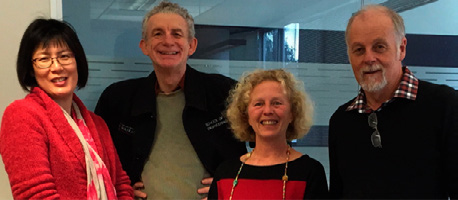
The project team (from L to R): Elaine Khoo, Jonathan Scott, Mira Peter, and Howell Round (absent: Bronwen Cowie)
The project website can be found at: http://www.waikato.ac.nz/wmier/research/projects/how-flipped-classrooms-afford-transformative-teaching,learning,-and-workplace-competency
Appendix 1
| Semester and flipped class teaching-learning | Focus of the course videos | Total number of lecture videos | Tools/software used to create videos | Flipped class design |
|---|---|---|---|---|
| Cycle 1: Semester A 2015 (2015A), 3 weeks of flipped class learning between weeks 2–4 | Lecturer 1 developed 3 weeks’ worth of videos covering TC1 | 33 | Writing tablet
SmoothDraw software to animate drawings on the tablet Camtasia software (a screencast recording software) to record Final Cut Pro software for editing videos (post- production) Completed videos were then uploaded into the Panopto software and linked into the course Moodle site |
During the 3 weeks of intervention an extended but partial flip design was adopted
The weekly 3-hour lab sessions were extended to 4 hours to allow an extra hour for student group problemsolving activities prior to the 3-hour lab work |
| Cycle 2: Semester T 2015 (2015T) | Lecturer 1’s purpose-made videos covering TC 1 and TC 2 in
the first half of the course Lecturer 2’s past course-cast lecture videos covering the remaining half of the course |
39
6 |
Lecturer 1 purpose-made videos from 2015A
New set of Lecturer 1 purpose-made videos using Lightboard (Lecturer 1 designed and built this for recording his teaching) Video camera with in-built mic Adobe Premier software to capture the recording Final Cut Pro software to edit the videos before uploading into Panopto Panopto recorded videos of Lecturer 2’s face-to-face lectures |
Fully flipped course design |
| Cycle 3: Semester A 2016 (2016A) | Lecturer 1’s purpose-made videos
Lecturer 2’s purpose-made videos |
43 videos
(for Lecturer 2) |
Lecturer 1’s purpose-made videos
Lecturer 2’s purpose-made videos using: Powerpoint Desktop computer with inbuilt webcam and mic Camtasia software to record Final Cut Pro software for editing the videos Lecturer 2 also made use of Google Forms to embed questions at specific points in his videos to quiz students’ understanding of the video content |
Fully flipped course design |
| Cycles 4 (2016T) and 5 (2017A) | Same as cycle 3 | Same as cycle 3 | Same as cycle 3 | Same as cycle 3 |

